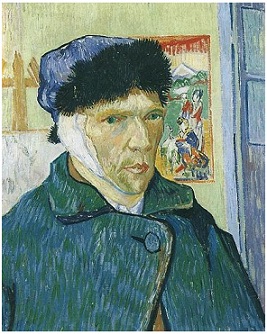Both of the above portraits are of the same man, Vincent van Gogh (1853-1890). Both were painted by the artist -- one of the most prolific self-portraitists ever, with over 40 self-drafted (drawn and painted) images of himself, and all between 1886 and 1889. They are both similar -- they are the artist. Yet the are also different. As the Wikipedia article on van Gogh states, "In all, the gaze of the painter is seldom directed at the viewer; even when it is a fixed gaze, he appears to look elsewhere. The paintings vary in intensity and color and some portray the artist with beard, some beardless, some with bandages – depicting the episode in which he severed a portion of his ear."* Given the number of self-portraits, as well as the varying poses -- yet with almost all showing the artists head from the right side, one must wonder what drove him to such output in such a compressed period of time.
I began thinking of van Gogh's work on Tuesday evening at DU's "Bridges to the Future" lecture by Prof. Alice Marwick of Fordham University. Prof. Marwick's address was entitled, "Privacy and Publicity in the Social Media Age", but she did not approach the topic so much from the standpoint of privacy "violations" or even privacy settings on Facebook (although she did touch on those). Rather she chose to examine these concepts through the medium of the "selfie" -- the now-ubiquitous self-photograph-posted-to-social-media (her statistics on this were astonishing!). She pointed out that the photos we choose to upload for public consumption (even if a small, selected, public) are chosen with two main criteria in mind: context and audience.
Context and audience. We "shoot" ourselves in certain places and times, in certain poses, or with certain backgrounds, and then accompany the photo with a caption or some lines of text that help provide the viewer with some idea WHY we chose that photo ("Look at me here in LOVELY Mazatlan on the beach with an umbrella in my drink! Wish you were here (you unlucky sot, stuck in snow-bound New England!)" And, then, of course, we know pretty much who will see the photo. If we are a celebrity, it will be our fans. It may be directed at our family and/or friends (depending on with whom we're connected in our social media world). In other words, we're telling a story with the photo/caption to an audience we know will (or should) understand. But every selfie will tell a different story, as the context (and perhaps the audience) will differ.
And so I began to wonder about van Gogh. Some of the portraits have the "swirrly-line" background (like the one on the top). Others help provide context, such as the in-home background in the one on the bottom. Some chose to hide the fact that he had taken a knife to his ear (as on the top). Very few show the bandage (on the bottom). And very few depict the artist without his beard. Yet they are all, unmistakably, Vincent van Gogh.
And so I began to wonder about van Gogh. Some of the portraits have the "swirrly-line" background (like the one on the top). Others help provide context, such as the in-home background in the one on the bottom. Some chose to hide the fact that he had taken a knife to his ear (as on the top). Very few show the bandage (on the bottom). And very few depict the artist without his beard. Yet they are all, unmistakably, Vincent van Gogh.
It didn't take long for me to take another "leap" in thinking, given my background in religion. I'm certainly familiar with the somewhat standard "defense" of multiple religions: "they are all different paths up the same mountain (i.e., "up" to God)." I, myself, prefer a variation on that theme: "different religions are different paths down the mountain (i.e., God reaching to us)". Prof. Marwick's description of the selfie prompted a slight revision.
Those of us who have taken and posted "selfies" have done so, consciously or unconsciously (according to Marwick) recognizing the reasons why, and to whom, we're posting the photo. We are careful (some of the time) NOT to post embarrassing photos, worrying that mom, Uncle Ralph, or a future employer might see them. Or we intentionally post wonderful shots with some luminary/hero to show our association with greatness. Both sets of selfies are US.
Being of a sociological-bent, I have long adopted a view of scripture as human attempts, given their particular socio-cultural-political situations, to make sense of divine actions (or inactions) in their individual or corporate lives. But what if we see sacred writings as selfies, divine attempts to reach a particular audience in and from a particular context? Folks have long noted that there are themes common to most religions, yet often debunk religions because of the differences. Could the "divine selfie" theory help here? God to us in ancient India. God to us in ancient Israel. God to us . . .?
There are some challenging sidelights to the idea, but every theistic tradition has a notion of divine love/concern directed at the earth's inhabitants. What's so strange about a compassionate God sending a self-portrait to each of us, in terms we would understand?
They might not be the same picture, the same pose, the same background -- but come from the same Source.There are some challenging sidelights to the idea, but every theistic tradition has a notion of divine love/concern directed at the earth's inhabitants. What's so strange about a compassionate God sending a self-portrait to each of us, in terms we would understand?
I mean, which of the two portraits above is REALLY van Gogh?
Blessings,



No comments:
Post a Comment